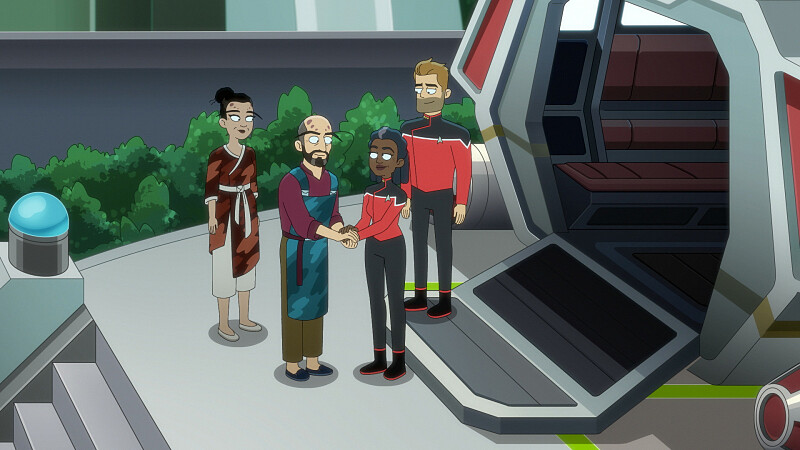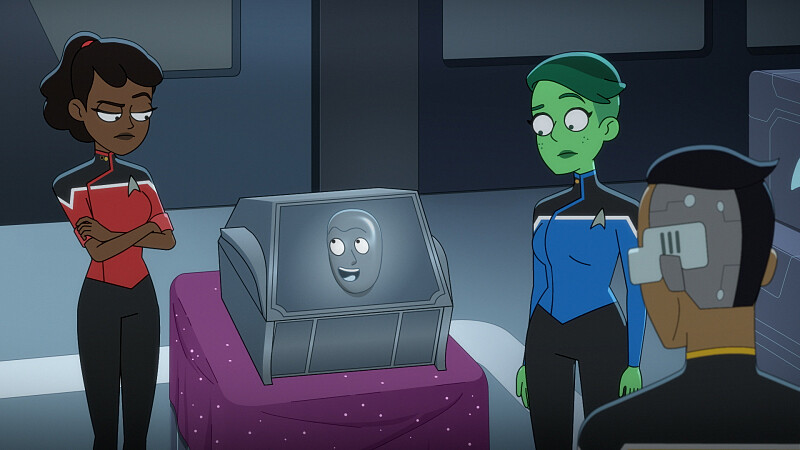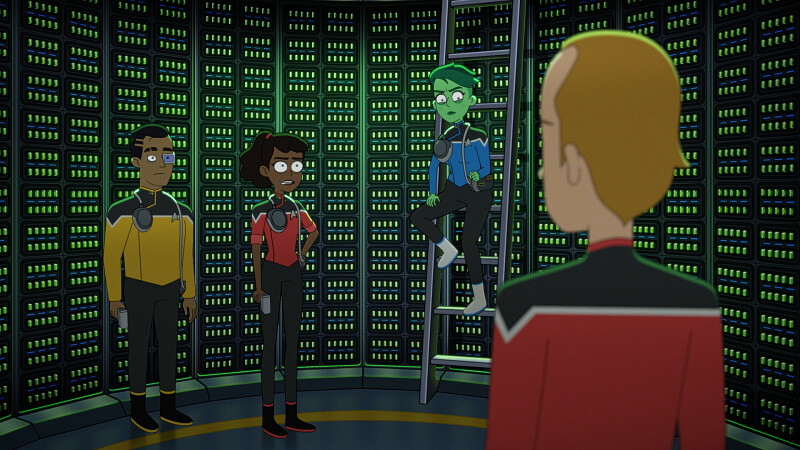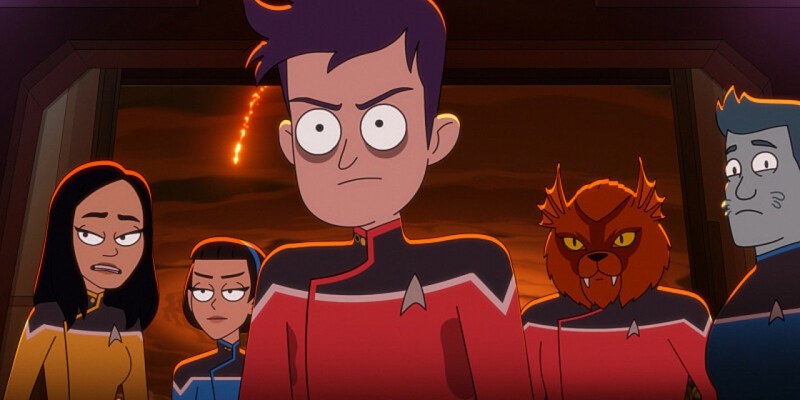This discussion and review contains spoilers for Star Trek: Lower Decks season 4, episode 3, “In the Cradle of Vexilon,” streaming now on Paramount+.
The opening three episodes of the fourth season of Star Trek: Lower Decks provide a nice tasting menu of the show’s three main varieties of episode. If “Twovix” was a nostalgic throwback and “I Have No Bones Yet I Must Flee” was a conventional sitcom episode, then “In the Cradle of Vexilon” is a classic Star Trek episode delivered with a slightly comedic bent. It is an episode of Lower Decks that could fairly easily be adapted for Star Trek: The Next Generation or Star Trek: Voyager, with only a slight tweak in tone.
To be fair, this division is imperfect. “I Have No Bones Yet I Must Flee” featured a plot thread that was very clearly riffing on an archetypal Star Trek narrative, the “classic menage.” Similarly, “In the Cradle of Vexilon” has an entire sitcom-esque subplot in which Mariner (Tawny Newsome), Tendi (Noël Wells), and Rutherford (Eugene Cordero) deal with being “hazed” by Lieutenant Dirk (Phil LaMarr) following their promotion. Still, “In the Cradle of Vexilon” feels much more like a traditional Star Trek episode.
As with a lot of Lower Decks episodes, “In the Cradle of Vexilon” is saturated with nostalgic throwbacks to Star Trek lore. Most of these come via “the anomaly storage room,” which includes a Betazoid gift box like that featured in “Haven,” a Chula game like the one from “Move Along Home,” and even a probe recalling the one found in “The Inner Light.” It is honestly a bit much, even confined to the episode’s tertiary plot thread.
“In the Cradle of Vexilon” is more interesting when it instead looks outside the franchise’s existing continuity. The episode finds the Cerritos visiting Corusonia, “an artificial megastructure in a bespoke star system designed by a long-extinct alien species.” It is not a planet, it is a rotating wheel artificial world of the kind popularized by Larry Niven’s Ringworld saga.This is a wonderful science fiction concept, like the Dyson Sphere that appeared in “Relics.”
It is a shame that Star Trek doesn’t embrace these sorts of big ideas more frequently, embracing its literary science fiction heritage. Pointedly, Boimler’s (Jack Quaid) away team includes Ensign Taylor (Fred Tatasciore). Taylor is a Kzinti, a member of the alien race created by Larry Niven for his one and only Star Trek script, “The Slaver Weapon.” As such, the decision to present Corusonia as a ringworld feels like a deliberate shoutout to Niven, known as “the master of hard sci-fi.”

L-R Dawn Lewis as Captain Carol Freeman and Jerry O’Connell as Commander Ransom appearing in episode 3, season 4 of Lower Decks streaming on Paramount+, 2023. Photo Credit: Paramount+
Interestingly, “In the Cradle of Vexilon” doesn’t dwell too heavily on the design of Corusonia. It is just a clever background detail, a way to add some much needed variety to the larger Star Trek universe by demonstrating that it consists of more than planets and space stations. Instead, the Cerritos has been assigned to investigate some strange behavior on part of Vexilon, “the environmental computer installed by the ring’s original designers.”
This is a classic Star Trek story. The franchise is full of malfunctioning artificial intelligences, from the M-5 in “The Ultimate Computer” to Vaal in “The Apple.” Indeed, Nomad from “The Changeling” can be glimpsed in “the anomaly storage room.” More specifically, Lower Decks is preoccupied with these sorts of threats, such as Badgey (Jack McBrayer) from “Terminal Provocations” to Peanut Hamper (Kether Donohue) in “No Small Parts” to AGIMUS (Jeffrey Combs) in “Where Pleasant Fountains Lie.”
Lower Decks is a Star Trek show very much about the idea of work and labor. As such, it makes sense that the series is also preoccupied with the question of automation and technological advancement. Of course, this fear also plays out through other modern Star Trek shows, such as the second season of Star Trek: Discovery or the first season of Star Trek: Picard, but it is a source of constant fascination for Lower Decks. The third season finale, “The Stars at Night,” imagined the crew replaced by automation.
A large part of the charm of “In the Cradle of Vexilon” derives from playing with that expectation. The central joke of the episode is that Vexilon is not evil or psychotic. As Captain Freeman (Dawnn Lewis) notes in her opening log, “Fortunately, Vexilon is a benevolent ally with no interest in world domination.” When she beams down, her first question to the indigenous population is, “He’s not trying to subjugate anyone, is he? I thought he was a friendly computer.”
Vexilon is a friendly computer. However, he is also very old. When his malfunctions are explained, Freeman summarizes the underlying issue, “Your world computer’s lagging?” It’s a very clever twist on the classic evil computer story, one that is very well observed. “In the Cradle of Vexilon” isn’t about a monstrous computer threatening to enslave its operators. It is a story about how frustrating it is for a person to have to upgrade their work computer.

L-R Tawny Newsome as Ensign Beckett Mariner and Noel Wells as Ensign Tendi appearing in episode 3, season 4 of Lower Decks streaming on Paramount+, 2023. Photo Credit: Paramount+
Freeman quickly determines that Vexilon’s “operating system is out of date,” which makes sense given that his last update was “six million and seven years ago.” As Lieutenant Billups (Paul Scheer) notes, “This is a classic setup.” Placing it in the context of Noonien Soong’s (Brent Spiner) positronic breakthroughs, he jokingly asks, “Is it a unitronic?” The bulk of the episode concerns Freeman’s efforts to install those updates and get Vexilon operating at peak efficiency.
“In the Cradle of Vexilon” is a charming and relatable riff on the archetypal “evil computer” story, a script that takes the relatable frustration of trying to update a personal computer and applies it to the planetary scale of these computers within the larger Star Trek canon. It’s a wonderful premise for an episode. “No big deal,” Freeman boasts as the planet starts to implode around her. “Just a frozen progress bar and some crazy day-night stuff.”
The primary plot of “In the Cradle of Vexilon” focuses on Freeman, but the two other plot threads flow from the promotions at the end of “Twovix.” As with “I Have No Bones Yet I Must Flee,” this is an episode about the leading quartet adjusting to their new ranks. Mariner, Tendi, and Rutherford have to deal with Dirk’s bullying, while Boimler finds himself in charge of his first away mission. As “Boss Boimler,” the young officer is placed in a position of true authority over his subordinates.
Like “I Have No Bones Yet I Must Flee,” this is a classic Star Trek story in which the lead character comes to a personal revelation. In that sense, it’s very similar to the structure that Michael Piller refined on The Next Generation. The story isn’t necessarily about Vexilon or Corusonia so much as it is about what the trip to Corusonia teaches Boimler about himself. He has to learn what it means to be in a command position, to give orders to others and to make potentially tough choices.
This is another classic Star Trek plot, and one that makes perfect sense in the context of Lower Decks. The series is famously named for an episode from the final season of The Next Generation, which was full of episodes about characters learning to assert themselves and make decisions in heated situations. Beverly Crusher (Gates McFadden) has to confront Barnaby (James Horan) in “Descent, Part II,” while Deanna Troi (Marina Sirtis) tries to pass the command exam in “Thine Own Self.”

L-R Eugene Cordero as Ensign Rutherford, Tawny Newsome as Ensign Beckett Mariner and Noel Wells as Ensign Tendi appearing in episode 3, season 4 of Lower Decks streaming on Paramount+, 2023. Photo Credit: Paramount+
On his “first mission as commander”, Boimler struggles to assert himself over junior officers that were his peers. He struggles to figure out how best to lead the team, confessing to T’Lyn (Gabrielle Ruiz), “I’ve had good bosses and bad ones – I just don’t want to repeat their mistakes.” It’s a very sincere and very earnest character arc, one that could easily have been played pretty much as it is on The Next Generation.
Boimler’s story in “In the Cradle of Vexilon” is a prime and affectionate example of the kind of Star Trek that critic Josh Marsfelder described as “children’s television for adults.” It’s a sincere and teachable moment about a character confronting an interpersonal obstacle and figuring out how best to work through it. It is really not too dissimilar from Wesley (Wil Wheaton) learning to assert himself over Ensign Davies (Nicholas Cascone) in “Pen Pals.”
“In the Cradle of Vexilon” ends with Boimler going through his own initiation, not so different from the one that his friends are experiencing on the ship. He is killed during the mission, although he is subsequently revived. “You never forget your first death,” Commander Ransom (Jerry O’Connell) advises him. It’s nice that Lower Decks has accrued enough internal continuity that Boimler’s afterlife can reference, as Steve Stevens (Ben Rodgers) described it, “a koala sitting on a black mount[ain].”
The biggest problem with “In the Cradle of Vexilon” is the hazing subplot involving the three other leads. It’s largely a collection of overstuffed continuity references that doesn’t necessarily lead anywhere. There’s no real resolution to the storyline, in part because the final punchline that reveals that Dirk was hazing them removes a lot of the agency from the trio. It is fun to see Rutherford speed-running the Chula game from “Move Along Home,” but it’s a largely empty subplot.
Still, “In the Cradle of Vexilon” is a reminder that Lower Decks is perfectly capable of putting its own spin on a classic Star Trek story. Freeman’s plot thread finds a fresh angle on a familiar narrative template, while Boimler’s character arc is a very old-fashioned Star Trek story. This is the sort of storytelling that Star Trek: Strange New Worlds frequently attempts but rarely accomplishes, a loving homage to the narrative frameworks of The Next Generation that has had a minor software upgrade.
